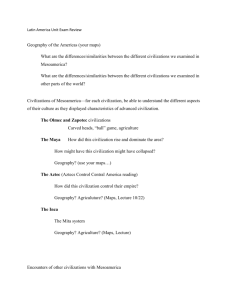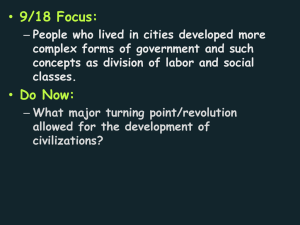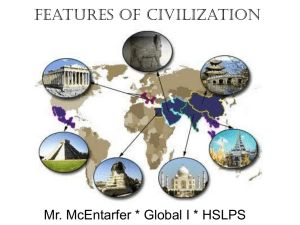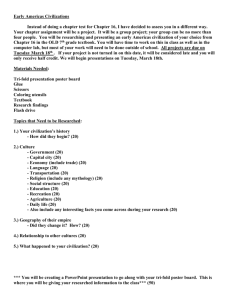6th Grade SS Unit 2
advertisement
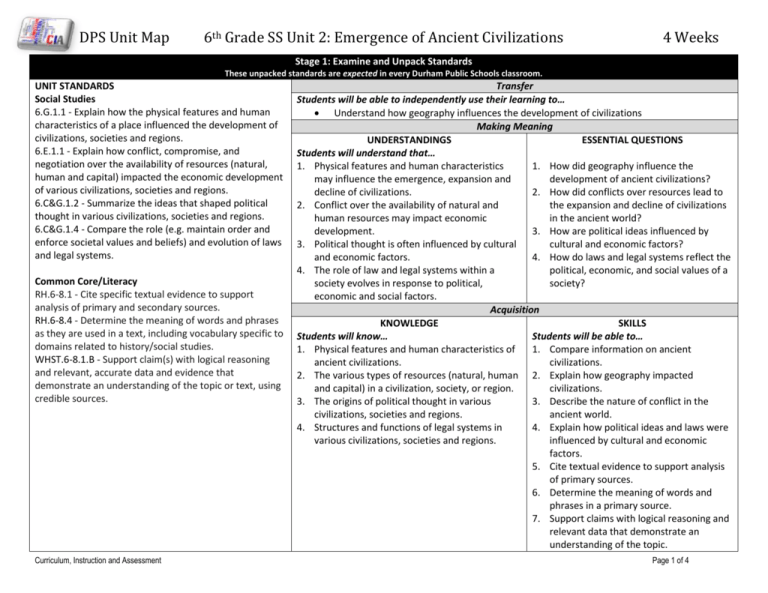
DPS Unit Map 6th Grade SS Unit 2: Emergence of Ancient Civilizations 4 Weeks Stage 1: Examine and Unpack Standards These unpacked standards are expected in every Durham Public Schools classroom. UNIT STANDARDS Social Studies 6.G.1.1 - Explain how the physical features and human characteristics of a place influenced the development of civilizations, societies and regions. 6.E.1.1 - Explain how conflict, compromise, and negotiation over the availability of resources (natural, human and capital) impacted the economic development of various civilizations, societies and regions. 6.C&G.1.2 - Summarize the ideas that shaped political thought in various civilizations, societies and regions. 6.C&G.1.4 - Compare the role (e.g. maintain order and enforce societal values and beliefs) and evolution of laws and legal systems. Common Core/Literacy RH.6-8.1 - Cite specific textual evidence to support analysis of primary and secondary sources. RH.6-8.4 - Determine the meaning of words and phrases as they are used in a text, including vocabulary specific to domains related to history/social studies. WHST.6-8.1.B - Support claim(s) with logical reasoning and relevant, accurate data and evidence that demonstrate an understanding of the topic or text, using credible sources. Curriculum, Instruction and Assessment Transfer Students will be able to independently use their learning to… Understand how geography influences the development of civilizations Making Meaning UNDERSTANDINGS ESSENTIAL QUESTIONS Students will understand that… 1. Physical features and human characteristics 1. How did geography influence the may influence the emergence, expansion and development of ancient civilizations? decline of civilizations. 2. How did conflicts over resources lead to 2. Conflict over the availability of natural and the expansion and decline of civilizations human resources may impact economic in the ancient world? development. 3. How are political ideas influenced by 3. Political thought is often influenced by cultural cultural and economic factors? and economic factors. 4. How do laws and legal systems reflect the 4. The role of law and legal systems within a political, economic, and social values of a society evolves in response to political, society? economic and social factors. Acquisition KNOWLEDGE SKILLS Students will know… Students will be able to… 1. Physical features and human characteristics of 1. Compare information on ancient ancient civilizations. civilizations. 2. The various types of resources (natural, human 2. Explain how geography impacted and capital) in a civilization, society, or region. civilizations. 3. The origins of political thought in various 3. Describe the nature of conflict in the civilizations, societies and regions. ancient world. 4. Structures and functions of legal systems in 4. Explain how political ideas and laws were various civilizations, societies and regions. influenced by cultural and economic factors. 5. Cite textual evidence to support analysis of primary sources. 6. Determine the meaning of words and phrases in a primary source. 7. Support claims with logical reasoning and relevant data that demonstrate an understanding of the topic. Page 1 of 4 DPS Unit Map 6th Grade SS Unit 2: Emergence of Ancient Civilizations 4 Weeks Key Vocabulary Tier 3 Vocabulary Words city-state, cuneiform, pharaoh, caste system, hieroglyphics Tier 2 Vocabulary Words irrigation, dynasty, authority, distribution Notable Individuals, Places, Events, and Documents Fertile Crescent, Nebuchadnezzar, Tigris/Euphrates Rivers, Sanskrit, Zhou Dynasty, Great Wall of China, Huang He, Mandate of Heaven, Shang Dynasty, Sumer, Hammurabi’s Code, Nile River/Delta, Indus River, Aryans, Harrapa, Mohenjo Daro Stage 2: Calibrate Rigor and Design Assessment Evaluative Criteria for Assessment District Provided Assessment Tasks Rubric Performance Task Choice #1: Criteria 1 2 3 Students should create a presentation that depicts someone performing an occupation The product The product that existed in multiple river valley civilizations. Students may work individually or in The product does not partially groups to research an occupation from the time period (i.e. fishing) and present addresses the Addressing the address the addresses the information on how it was important to ancient societies. goal of the prompt goal of the performance task. goal of the performance task. performance task. Cite Evidence (from text – primary or secondary sources) There is no evidence to support the answer. Examples are provided that loosely support the answer. Examples are provided that fully support the answer. Explain No attempts to explain how the evidence addresses the prompt have been made. Conventions Many grammatical errors exist that obscure meaning. Curriculum, Instruction and Assessment The attempts to explain how the evidence addresses the prompt are unclear or insufficient. Some grammatical errors exist, but do not obscure meaning. The explanation of the evidence is clear and insightful. No grammatical errors exist. Performance task Choice #2: Select one of the Ancient River Valley civilizations. Write an article for the National Geographic magazine describing the selected civilization as well as how the unique geographic features influenced the development of that ancient civilization. Be sure to include how agriculture, technology, government, social structure, economy, and geography shaped the development of civilization. In the article include an opening statement, supporting details, and a closing statement. Performance Task Choice #3: Goal: to establish a permanent civilization Role: You are the leader of your people Audience: The people of your would-be civilization Situation: You are starting your own civilization. Your people have been wandering around for years, hunting and gathering food from place to place. You are trying to convince your people that moving to the Indus valley in India, home of the Ganges and Brahmaputra rivers, will be the perfect location. Using your expertise on early civilizations tell the people the ability for your civilization to exist based on given geographic features. Justify settling into the region. Remember what you already know, and apply it. Use the space below to outline your writing. Tell your people about: Page 2 of 4 DPS Unit Map 6th Grade SS Unit 2: Emergence of Ancient Civilizations 4 Weeks ❖ Why does the geography make this a great place to start a civilization? ❖ The advantages of a settled life ❖ Food surplus ❖ Development of Religion ❖ Development of government ❖ Division of Labor ❖ Social Class Include in your speech why these topics are important to the greatness of your civilization, and why Product: write a speech that convinces your people to follow you to this new land to start a civilization Other Evidence – Embedded Stage 3 Learning Events Teacher designed Teacher designed DPS 6-8 RACER & ACES + C Rubric PLC designed Curriculum, Instruction and Assessment Minute by Minute Assessments Speech, Debate or Socratic Seminar Text-Dependent Constructed Response Questions PLC-Created Text or Concept Specific Common Formative Assessments Page 3 of 4 DPS Unit Map 6th Grade SS Unit 2: Emergence of Ancient Civilizations 4 Weeks Stage 3: Plan and Deliver Instruction This instructional pacing and sequencing represents one best practice option. Professional Resources Instructional Resources Resources for Unit Concepts: Teachers to Watch: 1 # of Days 5 2 5 3 7 4 3 Summary of Key Learning Events, Opportunities, and Instruction Focus of Lesson Standard(s) Support The Rise of Civilization in 6.G.1.1, Students will take a look at the geography of Mesopotamia/Fertile Crescent. From there students Mesopotamia/Fertile Crescent 6.C&G.1.4, will study the rise of the kingdom of Sumer. This will include how society was structured and the 6.E.1.1 achievements of the people. The students will then study the Babylonians. This will include a study and analysis of Hammurabi’s code of laws as well as how society was structured and the achievements of the people. Next, students could move on to the invasions of Mesopotamia, which will include the Hittites, Assyrians, and Chaldeans. Ancient Egypt 6.G.1.1, Following the study of Mesopotamia we will begin with the geography of Ancient Egypt. Students 6.C&G.1.2, will compare the geography to that of Mesopotamia. Students will study the rise of Egypt from 6.E.1.1 the Old Kingdom to the Middle Kingdom then onto the New Kingdom. In the New Kingdom, students can focus on the achievements of the Ancient Egyptians. Indus and Chinese River Valley 6.G.1.1, This section will begin with the geography of the Indus River Valley. Students will compare the Civilizations 6.E.1.1 geography to that of Mesopotamia and Ancient Egypt. Students will then examine the Harappan and Aryan civilizations, including their rise, structure of society, and achievements. This section will begin with the geography of China’s Huang He River Valley. Students will examine the rise of dynasties in this region, starting with the Shang dynasty and then moving onto the Zhou, Qin, and Han dynasties (Qin and Han dynasties will also work with the government section). Students will specifically focus on family structure, the Great Wall, inventions, writing, and art. Review and assessment All Complete Performance Task listed above Curriculum, Instruction and Assessment Page 4 of 4



